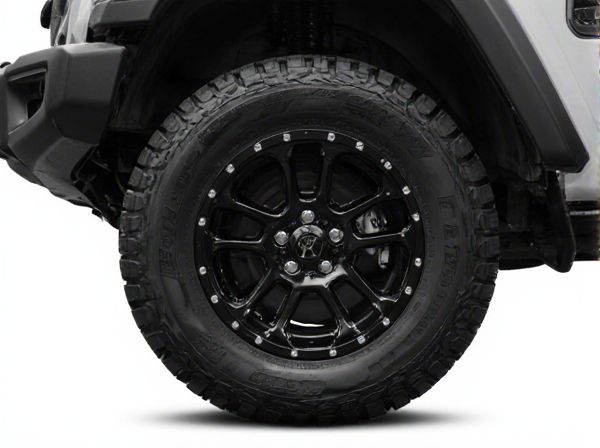
Photo illustration: Staggered Fitment vs Square Fitment
Staggered fitment features different tire sizes on the front and rear axles, enhancing traction and handling performance for rear-wheel-drive vehicles. Square fitment uses identical tire sizes on all four wheels, promoting even tire wear and simpler maintenance. Choosing the right fitment impacts Your vehicle's balance between performance, aesthetics, and tire longevity.
Table of Comparison
| Feature | Staggered Fitment | Square Fitment |
|---|---|---|
| Tire Size | Different widths - wider rear, narrower front | Same width and size on all four wheels |
| Performance | Improved rear traction and handling in powerful cars | Balanced handling and predictable cornering |
| Tire Rotation | Limited or no rotation possible | Full rotation extends tire life |
| Cost | Higher due to varied tire sizes | Lower, easier to replace and maintain |
| Common Usage | Sports cars, rear-wheel drive vehicles | Daily drivers, all-wheel and front-wheel drive cars |
Introduction: Understanding Wheel Fitment
Wheel fitment determines how tires and rims align with a vehicle's suspension and body, directly impacting handling, aesthetics, and performance. Staggered fitment uses different sizes for front and rear wheels, typically wider at the rear to improve traction and cornering balance. Square fitment employs identical wheel and tire sizes on all four corners, promoting uniform wear and simplified maintenance.
What is Staggered Fitment?
Staggered fitment refers to a wheel setup where the rear wheels are wider than the front wheels, enhancing traction and handling, especially in rear-wheel-drive vehicles. This configuration improves cornering stability by providing greater grip at the rear, essential for performance driving and high-horsepower cars. Unlike square fitment, which uses identical tire sizes on all corners, staggered fitment prioritizes rear tire width for optimized power delivery and balance.
What is Square Fitment?
Square fitment refers to using wheels of the same size and offset on all four corners of a vehicle, promoting balanced handling and easier tire rotation. This setup enhances tire longevity and reduces uneven wear compared to staggered fitment, which employs different sizes for front and rear wheels. Square fitment is preferred for maximizing performance, cost efficiency, and uniform traction under various driving conditions.
Key Differences Between Staggered and Square Fitment
Staggered fitment features wider rear wheels and tires compared to the front, enhancing traction and handling performance, especially in rear-wheel-drive vehicles. Square fitment uses identical wheel and tire sizes on all corners, promoting even tire wear and simplified tire rotation. The key differences lie in traction optimization for staggered setups versus longevity and maintenance ease in square configurations.
Performance Impacts of Staggered Fitment
Staggered fitment, featuring larger rear wheels compared to the front, enhances traction and stability by improving rear grip during acceleration, especially in rear-wheel-drive vehicles. This setup optimizes handling dynamics by allowing wider tires at the rear, reducing understeer and improving cornering performance. However, it may cause increased tire wear discrepancies and can affect the ability to rotate tires evenly, impacting long-term maintenance.
Performance Impacts of Square Fitment
Square fitment offers balanced tire sizes on all four corners, enhancing predictable handling and consistent grip during cornering and acceleration. This uniform setup improves tire rotation options, leading to even tire wear and extended tire life. Performance stability gains from square fitment make it ideal for drivers seeking precise control and efficiency on both dry and wet road conditions.
Pros and Cons of Staggered Fitment
Staggered fitment, characterized by wider rear tires compared to the front, enhances traction and cornering stability, delivering improved performance in high-powered and rear-wheel-drive vehicles. However, this setup often limits tire rotation options, leading to uneven tire wear and higher replacement costs. While square fitment offers balanced wear and simplified maintenance, staggered fitment remains favored for its aggressive stance and superior grip during acceleration and cornering.
Pros and Cons of Square Fitment
Square fitment offers balanced handling and even tire wear due to identical front and rear tire sizes, promoting uniform performance across all wheels. However, this setup may sacrifice some rear traction and aggressive cornering capabilities compared to staggered fitment, which uses wider rear tires for enhanced grip. The main advantage lies in simplicity of tire rotation and lower replacement costs, while the downside includes potentially reduced aesthetic appeal and limited optimization for high-performance driving.
Choosing the Right Fitment for Your Vehicle
Choosing the right fitment for your vehicle depends on your driving style and aesthetic preferences. Staggered fitment, featuring wider rear wheels than the front, enhances traction and aggressive appearance, especially for rear-wheel-drive sports cars. Square fitment, with equal wheel sizes front and rear, provides balanced handling and easier tire rotation, ideal for all-wheel-drive vehicles and daily drivers.
Conclusion: Staggered vs Square Fitment Summary
Staggered fitment offers enhanced traction and aggressive aesthetics by using larger rear wheels combined with smaller front wheels, ideal for performance vehicles and sporty driving. Square fitment provides balanced handling and extended tire life through uniform wheel sizes, making it suitable for daily driving and all-wheel-drive cars. Choosing between staggered and square fitment depends on your vehicle's drivetrain, driving style, and desired performance characteristics.
 caratoz.com
caratoz.com